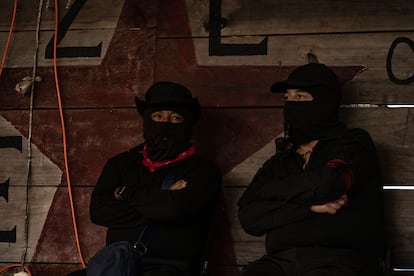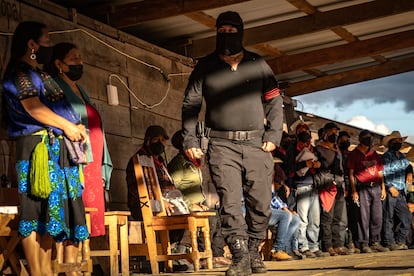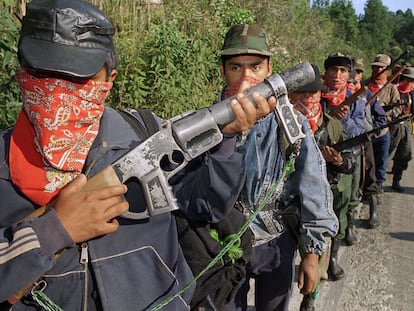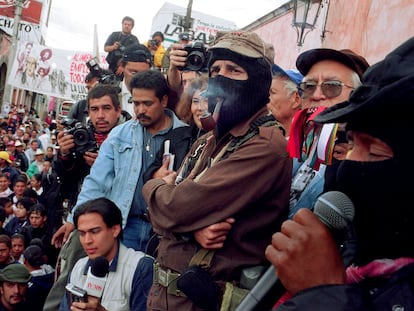The silence of Captain Marcos
The former deputy commander of the EZLN reappeared on the 30th anniversary of the Indigenous uprising but away from the spotlight, without saying a word, as part of his new role within the Mexican guerrilla movement

The captain no longer gives orders. He doesn’t want to be seen too much. Nor does he want to speak in public. Maybe he’s a little wistful because he wasn’t a captain before. He was the subcomandante. Subcomandante Marcos, the sup’, to his friends. Then he changed his nom de guerre to Galeano, but he was still the subcomandante. Now he has been demoted, or they have demoted him. At least he has been able to regain his name. The fact is that the most famous guerrilla in history — with a nod to Che Guevara — is no longer the visible face of the Zapatista Army of National Liberation (EZLN). Or at least he tries not to be, because no matter how much he insists that he is no longer in charge, people don’t care. The guy with the balaclava and the pipe in his mouth is still getting all the attention. He is the last living rock star of the left. Which at this point — the death of ideologies, rampant capitalism and all that — is perhaps not saying much.
Insurgent Captain Marcos, as he now calls himself, was seen again, after a long absence from the public eye, on the 30th anniversary of the uprising of January 1, 1994. He reappeared in the town of Dolores Hidalgo, in the green and misty vertigo of the mountains of Chiapas, a landscape well worth a revolution.
Things have changed a lot since 1994. At that time, Subcomandante Marcos was the face — the balaclava — of the EZLN, the spokesman, the undisputed symbol of the Indigenous insurgency that declared war on the government of Carlos Salinas de Gortari. But the years have gone by and the old subcomandante has grown tired of interviews and the spotlight. Since 2013, the main commander of the movement has been Subcomandante Moisés, who gave the speech on the night of December 31.

With his renewed aversion to the front pages, one imagines a hermit Marcos in a cabin in the Lacandon jungle, writing his emblematic communiqués to the rhythm of Keny Arkana, León Gieco, Panteón Rococo, Los Ángeles Azules or Joe Cocker - artists recently included in his publications in Enlace Zapatista. He has even provided instructions on how they should be danced to.
There, with paper and pencil, he has not ceased to hold forth on the state of Chiapas, Mexico and the world, with his usual parodic and malicious, intelligent and scathing prose. In his latest texts, he has written about things such as rage — “and if ever, in the unfinished book of history, someone sees a light, any light, without fuss or slogans, pointing out ‘this light was born of rage’?” — memory — “and, dear friends and enemies, few things are as subversive as memory” — or the mothers searching for their disappeared children — “their foolish dignity teaches and shows the way.”
In the back row
In his speech on December 31, Moisés spoke of the importance of deeds over words, of not humanizing capitalism and organizing against it, of practicing a life in common. He also recalled, in case anyone had forgotten, that the guerrillas are willing to wage war, despite the fact that so far they have opted for the peaceful path: schools and hospitals rather than shooting ranges: “We don’t need to kill the soldiers and the bad governments, but if they come, we are going to defend ourselves.”
Meanwhile, Marcos kept sucking on his incombustible pipe, sitting with his back against the wall behind Moisés, in the fourth row of seats with the rest of the EZLN command. He stood in the back row, in the middle, so that the camera lenses had to sharpen their gaze to find him among a sea of hooded heads.
A while earlier, he had arrived quietly through the back door. He was betrayed by a column of militiawomen formed in the darkness, who had to surround him to prevent unwanted approaches. Also, by the wisps of smoke that he was exhaling after savoring them. He looked a bit out of shape, far from the athletic figure that became famous during those 12 days of war in 1994. The years wait for no one and Marcos is already well into his sixties.
A journalist attempted to catch a shot. The red beam of the camera illuminated his balaclava for an instant; Marcos automatically put his hand to his face as if shooing away a fly and asked not to be photographed, in a gesture that hinted at irritation, although it impossible to know for sure: again, the balaclava...
On the stage, the captain watched militiamen and militiawomen parade-dance to the rhythm of cumbias and ska and perform military maneuvers in the dark, while listening to the words of Moisés. When the subcomandante finished his speech, fireworks exploded, half in celebration, half as a decoy as Marcos disappeared back into the night, flanked by the militias, to a wooden hut.
The following day he was seen again in the afternoon during another parade. A group of Otomí women, dressed in their best clothes, gave him handmade dolls with the red star and the initials of the EZLN. They embraced him one by one. Then, the captain smiled, but little else.
Subcomandante Marcos and idealistic romanticism
Marcos’ attempt to distance himself from the spotlight goes back a long way, to when he was still subcomandante. From the initial days of the uprising, the cameras showed a predilection for him over the rest of his comrades, which is paradigmatic, since he was one of the few non-Indigenous militiamen in a guerrilla group of Tzotzils, Tzeltales, Choles, Tojolabales, Mames, and Zoques. He had charisma — although he did not like the adjective — and his own way of molding words.
His writings brimmed with literary resources, references to both high-caliber intellectuals and pop culture, memorable phrases and a corrosive self-parodic humor, something uncommon in the usual revolutionary solemnity. “What happens is that the image of Marcos responds to romantic, idealistic expectations. In other words, he is the white man in the Indigenous milieu, closest to what the collective unconscious has as a reference: Robin Hood, Juan Charrasqueado, etcetera,” he once told the also mythical journalist Julio Scherer García. “Believe me, we are much more mediocre than people think,” he added.
In that 2001 interview, Scherer asked Marcos about his failures. He answered: “Marcos’ fundamental mistake is not having taken care — and I forgive him because it is me, and if I don’t forgive him, then who forgives him, right? — for not having foreseen this personalization and protagonism that many times, if not most of the time, prevents us from seeing what is behind it.” The conversation took place in the context of “The March of the Color of the Earth,” when the then-Subcomandante entered a crowded Zócalo, the main square in central Mexico City and the symbolic center of national power, on board the trailer of a truck to cheering supporters to demand President Vicente Fox comply with the San Andrés Accords of 1996 and to approve the autonomy of Indigenous peoples in Congress.
In 2006, during “The Other Campaign,” a journey in which the Zapatistas toured the country to try to form a leftist front beyond the one running for the presidency that year, he tried for the first time to leave behind the Marcos character. He called himself Delegate Zero, but the new nickname did not stick and the press continued with the Subcomandante Marcos handle, much to his chagrin. In 2014, he renamed himself Subcomandante Galeano, in honor of a murdered Zapatista professor. The new wartime moniker endured until last October, when he announced the metaphorical death of Galeano and reclaimed Marcos, with the customary demotion to captain.
In reality, Marcos was not even called Marcos at birth, although he says he was reborn on January 1, 1994. At the end of that year, the newly inaugurated President Ernesto Zedillo stripped the then-subcomandante of his balaclava in front of the whole country in an attempt to delegitimize him in the face of the massive popular support the EZLN was receiving. At that time, the government was negotiating with the guerrillas, and undermining Marcos’ figure would help to tip the balance in the administration’s favor. The ruse did not work very well. According to Zedillo, the hidden identity behind the hood was that of Rafael Sebastián Guillén Vicente, born in Tamaulipas in 1957, and the brother of a politician in the ruling Institutional Revolutionary Party. He was a student and later a professor of philosophy at the National Autonomous University of Mexico, where he won awards for his academic performance.
In 2001, Marcos confessed to Spanish journalist Concha García Campoy that he spent some time in Spain, where he worked in a bar and at the El Corte Inglés department store: “They threw me out of El Corte Inglés because I sold cheaper than the price tags said, and from the bar because I insisted on dancing to flamenco.” These experiences finally led him to return to Mexico, leave his books on ethics and metaphysics behind, and take to the mountains of Chiapas, from where he has never come down again.

Sign up for our weekly newsletter to get more English-language news coverage from EL PAÍS USA Edition
Tu suscripción se está usando en otro dispositivo
¿Quieres añadir otro usuario a tu suscripción?
Si continúas leyendo en este dispositivo, no se podrá leer en el otro.
FlechaTu suscripción se está usando en otro dispositivo y solo puedes acceder a EL PAÍS desde un dispositivo a la vez.
Si quieres compartir tu cuenta, cambia tu suscripción a la modalidad Premium, así podrás añadir otro usuario. Cada uno accederá con su propia cuenta de email, lo que os permitirá personalizar vuestra experiencia en EL PAÍS.
¿Tienes una suscripción de empresa? Accede aquí para contratar más cuentas.
En el caso de no saber quién está usando tu cuenta, te recomendamos cambiar tu contraseña aquí.
Si decides continuar compartiendo tu cuenta, este mensaje se mostrará en tu dispositivo y en el de la otra persona que está usando tu cuenta de forma indefinida, afectando a tu experiencia de lectura. Puedes consultar aquí los términos y condiciones de la suscripción digital.
More information
Archived In
Últimas noticias
The new victims of the Republican war on Obamacare: Millions hit by soaring health insurance premiums
A country divided on migrant rights: Some US states expand protections while others restrict them
Venezuela authorizes the release of another 87 political prisoners
There is as much life left to discover on planet Earth as that which is already known
Most viewed
- David King, chemist: ‘There are scientists studying how to cool the planet; nobody should stop these experiments from happening’
- Reinhard Genzel, Nobel laureate in physics: ‘One-minute videos will never give you the truth’
- Oona Chaplin: ‘I told James Cameron that I was living in a treehouse and starting a permaculture project with a friend’
- Sinaloa Cartel war is taking its toll on Los Chapitos
- The Interoceanic Train, the Mexican alternative to the Panama Canal










































